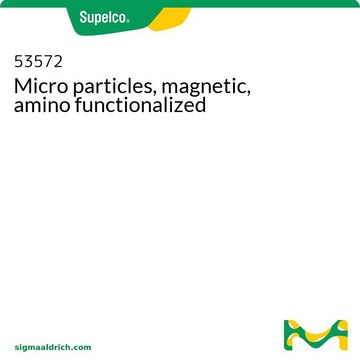推薦產品
產品線
TurboBeads™
化驗
≥99%
形狀
powder
成份
carbon content, ≤14 wt. %
反應適用性
reaction type: solution phase peptide synthesis
reactivity: copper reactive
標籤範圍
≥0.1 mmol/g loading (-Ph-CH2-N(CH2-COOH)2)
磁化
≥120 emu/g, mass saturation
表面積
≥15 m2/g
平均直徑
≤50 nm
適合性
conforms to structure for Infrared spectrum
包裝
Bottomless glass bottle. Contents are inside inserted fused cone.
分析報告
Proof of identity: metallic cobalt identity from XRD
air-stability:
weight gain in air at 400°C >20 wt.%
weight gain in air at 100°C <3 wt.%
air-stability:
weight gain in air at 400°C >20 wt.%
weight gain in air at 100°C <3 wt.%
法律資訊
TurboBeads is a trademark of TurboBeads LLC
儲存類別代碼
11 - Combustible Solids
水污染物質分類(WGK)
WGK 3
閃點(°F)
Not applicable
閃點(°C)
Not applicable
Jacinto Sá et al.
Nanoscale, 5(18), 8462-8465 (2013-07-12)
Non-magnetic Pt catalysts, supported on carbon coated magnetic Co nanoparticles, changed catalytic performance in the presence of an external magnetic field. This behavior relates to an electronic change of Pt induced by a localized magnetic field, which modifies the CO
Quirin M Kainz et al.
Chemistry (Weinheim an der Bergstrasse, Germany), 19(30), 10038-10045 (2013-06-19)
Unprecedented magnetic borohydride exchange (mBER), magnetic Wang aldehyde (mWang) and magnetic amine resins were prepared from highly magnetic polymer-coated cobalt or iron nanoparticles. Microwave irradiation was used to obtain excellent degrees of functionalization (>95 %) and loadings (up to 3.0 mmol g(-1))
Hideya Kawasaki et al.
Analytical chemistry, 84(21), 9268-9275 (2012-09-29)
Graphene-coated cobalt nanoparticles surface-functionalized with benzylamine groups (CoC-NH(2) nanomagnets) were shown to effectively enrich analytes for surface-assisted laser desorption/ionization mass spectrometry (affinity SALDI-MS) analysis. These CoC-NH(2) nanomagnets are highly suited for use with affinity SALDI-MS because their mean diameter of
Inge K Herrmann et al.
Nanoscale, 5(18), 8718-8723 (2013-08-01)
In a number of clinical conditions such as intoxication, bacteraemia or autoimmune diseases the removal of the disease-causing factor from blood would be the most direct cure. However, physicochemical characteristics of the target compounds limit the applicability of classical filtration
Vladimir Zlateski et al.
Bioconjugate chemistry, 25(4), 677-684 (2014-03-29)
In the pursuit of robust and reusable biocatalysts for industrial synthetic chemistry, nanobiotechnology is currently taking a significant part. Recently, enzymes have been immobilized on different nanoscaffold supports. Carbon coated metallic nanoparticles were found to be a practically useful support
我們的科學家團隊在所有研究領域都有豐富的經驗,包括生命科學、材料科學、化學合成、色譜、分析等.
聯絡技術服務






